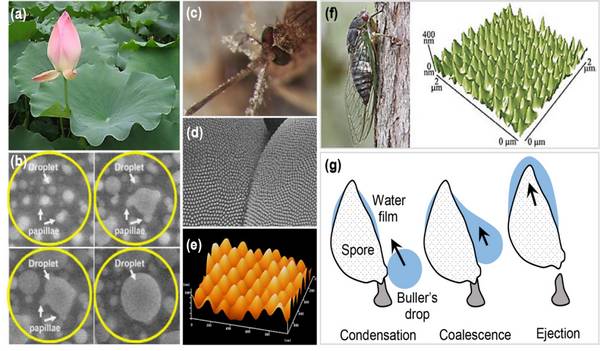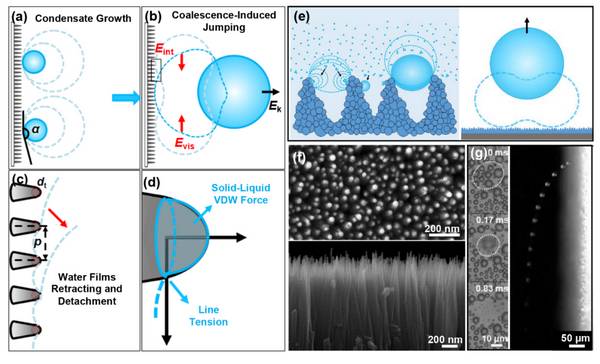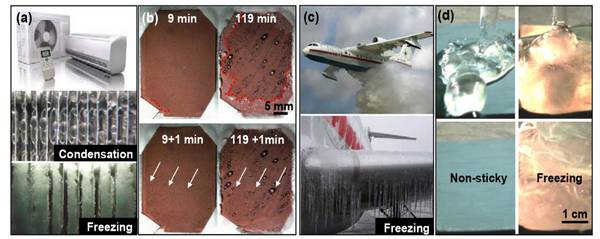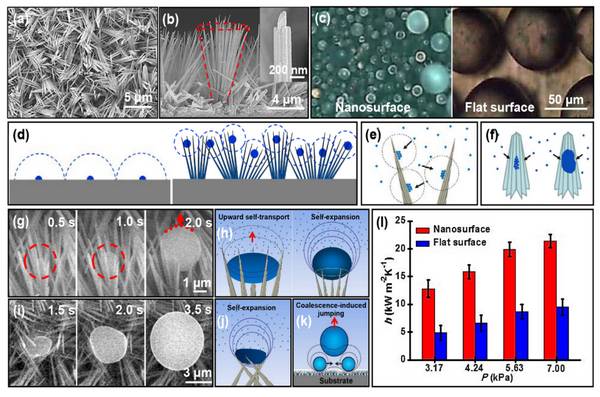Gao Xuefeng, Research Fellow, Suzhou Institute of Nanotechnology and Nano-Bionics, Chinese Academy of Sciences, focused on the design, preparation, performance regulation and potential applications of condensed droplet self-driving nano-bionic interface. Inspired by the principle of condensing droplet condensation on the surface of flaps and ejection spores, they first copied the polymer nanomass mastoid and nano-cone array structure (Chem. Commun.2012, 48, 11322; ACS Appl. Mater. Interfaces 2012, 4, 5678; Small 2014, 10, 2578), condensation kinetic studies show that the sharpening of the polymer nano mastoid top is the key to ensuring self-removal of condensed droplets (Adv. Mater. Interfaces 2015, 2, 1500238). Subsequently, they proposed a strategy of in-situ growth of densely aligned collimated nanoneedle on the surface of the material to achieve efficient self-ejection removal of small-scale condensed droplets. The combination of experiment and theory reveals that the extremely low solid-liquid adhesion of the nanostructure surface is to ensure the utilization of condensed droplets. The weak excess surface released by self-fusion enables the mechanism of self-ejection removal (J. Phys. Chem. Lett. 2014, 5, 2084). On this basis, the design principle of the functional interface building unit is proposed: the feature spacing is on the sub-micron scale to avoid water vapor intrusion; the sufficient height or depth is controlled to avoid the bottom of the suspension bridge contact structure; the solid-liquid interface is reduced by discrete protrusions. Adhesion to remove condensed droplets from ejection. Following this principle, a variety of nanoneedle cone configurations have been designed and manufactured (ACS Appl. Mater. Interfaces 2014, 6, 8976; ACS Appl. Mater. Interfaces 2015, 7, 10660; Adv. Mater. Interfaces 2016, 3, 1600362; ChemNanoMat2016 , 2, 1018), nanoparticle porous configuration (Angew. Chem. Int. Ed. 2015, 54, 4876) and nanorod-hole composite configuration (ACS Appl. Mater. Interfaces 2015, 7, 18206; ACS Appl. Mater Interfaces2015, 7, 11079) has excellent condensed droplet self-ejection removal function after low surface energy chemical modification.
Preliminary studies have shown that the combination of condensed droplet self-driving nano-bionic interface and micro-heat assisted technology can achieve continuous frost-free surface (ACS Appl. Mater. Interfaces 2014, 6, 8976). This innovative strategy will help to develop more Energy efficient air conditioning / heat pump heat exchanger. This bionic interface also has excellent super-cooling water non-stick function and is an ideal energy-saving technology for anti-freezing and freezing of aircraft wings (ACS Appl. Mater. Interfaces 2015, 7, 26391). In addition, this biomimetic interface has more efficient condensation heat transfer performance than common metal surfaces (ACS Appl. Mater. Interfaces 2015, 7, 11719; ACS Appl. Mater. Interfaces 2015, 7, 10660), and relevant knowledge innovations will help design Develop superior heat and mass transfer interface materials and thermal control devices.
Recently, they have been featured in the Advanced Materials magazine, and they have made special reports and comments on the latest research progress of condensed droplets self-driving nano-bionic interface (Adv. Mater. 2017, 29, 1703002, DOI: 10.1002/adma.201703002) The article deals with biological prototypes, mechanisms and construction principles of functional interfaces, preparation methods of metal-based functional interfaces, and recent advances in energy-related applications. Finally, the article also summarizes the current challenges and future developments in this research field. In particular, how to use other biomimetic strategies to design and develop a more excellent condensing droplet self-driving function interface.
The above work was supported by projects such as the Ministry of Science and Technology, the Fund Committee, the Chinese Academy of Sciences, and Jiangsu Province.

Figure 1. Biological prototype of the condensed droplet self-driving function interface. (ab) The low-viscosity and super-hydrophobic properties of the lotus leaf surface fail in a condensing environment, and the condensed droplets adhere firmly to the surface. (ce) Mosquito surface with water vapor non-stick function. (f) A flap surface having a condensation droplet self-removing function. (g) A model map of the ejection of spores by condensing droplets and self-ejection.

Figure 2. Principles for the construction of condensed droplets self-driving nano-bionic interface. (ad) Schematic diagram of condensed droplet fusion self-elastic removal on nanostructured surfaces. (e) Constructing the three principles of unit design. (fg) The strategy of in-situ growth of densely aligned collimated nanoneedles on the surface of the material to achieve self-elastic removal of condensed droplets.

Figure 3. Energy-saving application of nano-bionic interface: (a, b) Demonstration of anti-frosting requirements and functional interface effects of air-conditioning heat exchangers. (c,d) Demonstration of the requirements of the antifreeze and icing of the wing and functional interface effects.

Figure 4. Exploration of enhanced heat transfer at the nano-bionic interface. (a, b) SEM image of prismatic nanoneedle cluster structure. (c) The optical plot shows that the nano-surface has an extraordinary self-renewing function for small-scale condensed droplets compared to a smooth hydrophobic surface. (df) Model diagram of the high-density condensation nucleation mechanism of nanostructured surfaces. (g, h) Condensation droplets in the needle cluster from the transport-self-expanding growth mode. (i, j) Self-expanding growth mode of condensed droplets at the top of the cluster. (k) Model diagram of condensed droplet fusion self-ejector removal. (l) Comparison of the nanometer sample with the droplet condensation heat transfer coefficient of the copper surface.
Frame For Iphone X13 Pro,13 Promax Frame With Glue,Metal Frame For Iphone 13Promax,Lcd Frame For Iphone 13Promax
Shenzhen Xiangying touch photoelectric co., ltd. , https://www.starstp.com